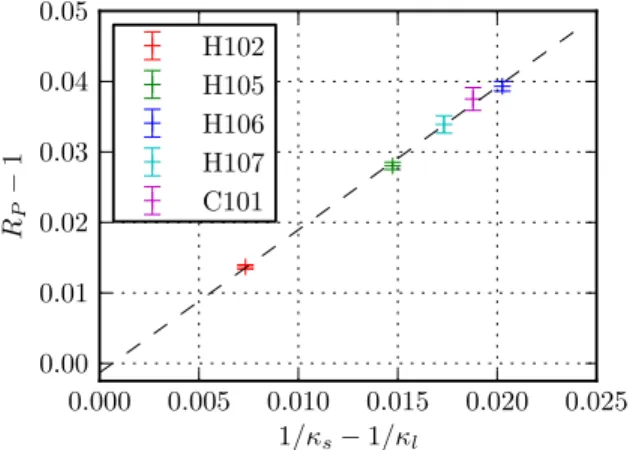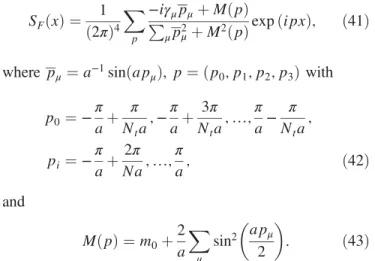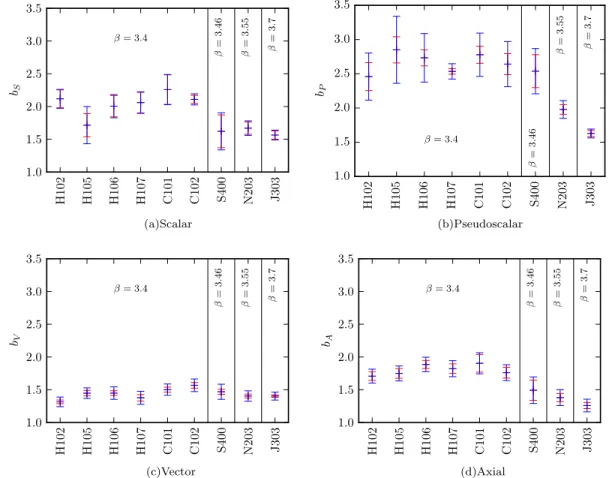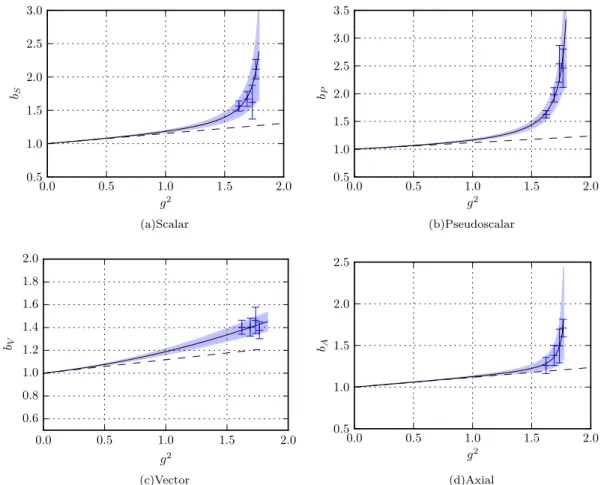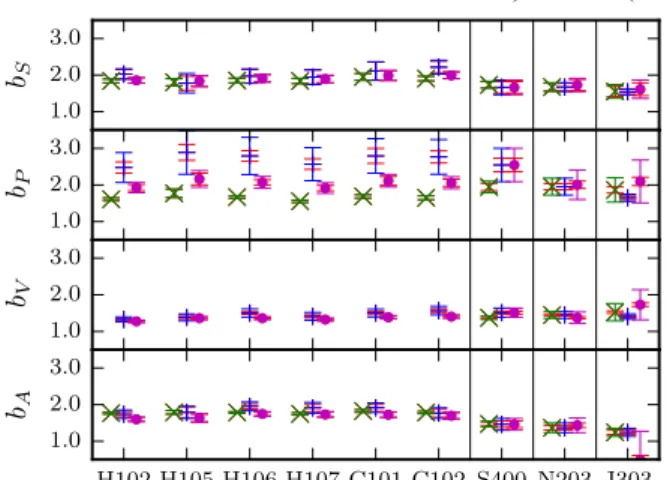Nonperturbative determination of improvement coefficients using coordinate space correlators in Nf = 2þ1 lattice QCD
Piotr Korcyl* and Gunnar S. Bali†
Institut für Theoretische Physik, Universität Regensburg, D-93040 Regensburg, Germany (Received 9 August 2016; published 13 January 2017)
We determine quark mass dependent orderaimprovement terms of the formbJamfor nonsinglet scalar, pseudoscalar, vector and axialvector currents using correlators in coordinate space on a set of Coordinated Lattice Simulations ensembles. These have been generated employing nonperturbatively improved Wilson fermions and the tree-level Lüscher-Weisz gauge action atβ¼3.4, 3.46, 3.55 and 3.7, corresponding to lattice spacings ranging froma≈0.085fm down to 0.05 fm. In theNf¼2þ1flavor theory two types of improvement coefficients exist:bJ, proportional to nonsinglet quark mass combinations, andbJ(orb~J), proportional to the trace of the quark mass matrix. Combining our nonperturbative determinations with perturbative results, we quote Padé approximants parametrizing thebJimprovement coefficients within the above window of lattice spacings. We also give preliminary results forb~J atβ¼3.4.
DOI:10.1103/PhysRevD.95.014505
I. INTRODUCTION
Lattice simulations of quantum chromodynamics (lattice QCD) have become an indispensable tool in particle and hadron physics phenomenology. By discretizing a quantum field theory on a lattice with a spacing a >0, ultraviolet divergences are regularized. At the same time this enables the numerical simulation of QCD, including its nonper- turbative dynamics. In principle such simulations need to be performed for different values of the lattice spacing, in order to remove the regulator by taking the continuum limit, a→0. In QCD this limit is approached as a polynomial ina, modulated by logarithmic corrections.
Obviously, many possible discretizations of the quark (and gluon) parts of the action exist. Staggered quarks suffer from conceptional problems, unless all fermions come in mass degenerate groups of four flavors. Also combining the flavor and spin degrees of freedom com- plicates operator mixing and the analysis of two- and three- point Green functions. Domain wall and overlap actions have the most desirable theoretical properties as even at a nonvanishing value of the lattice spacing these possess an (almost) exact chiral symmetry in the massless limit. In contrast, using Wilson fermions, chiral symmetry only becomes restored in the continuum limit, and also an additive mass renormalization is encountered. Wilson fermions, however, are computationally much less expen- sive to simulate and therefore offer the possibility of obtaining results at several values of the lattice spacing, enabling a controlled continuum limit extrapolation.
Unlike other fermion discretizations, where leading lattice artifacts are of ordera2, for naive Wilson fermions
these are linear ina. Such terms can, however, be removed nonperturbatively[1,2], Symanzik improving[3]the action and the local operators of interest. Recently, within the Coordinated Lattice Simulations (CLS) effort [4], we embarked on a large scale simulation program, employing Nf ¼2þ1 flavors of order a improved Wilson- Sheikholeslami-Wohlert [5] (clover) fermions and the tree-level improved Lüscher-Weisz gauge action [6,7].
CLS use open boundary conditions in time [8], thereby increasing the mobility of topological charges and enabling us to maintain ergodicity at finer lattice spacings than had been possible previously. For details on the action, ensem- bles and parameter values, see Ref.[4].
As the cost of simulations increases with a large inverse power of the lattice spacing, we aim at not only order a improving the action but also all operators that will appear in matrix elements of interest. It is important to remove such contributions, that are linear in a, nonperturbatively since terms of order g2νa, where g denotes the gauge coupling, will survive a (ν−1)-loop perturbative subtrac- tion. As g2 varies only slowly with a, close to the continuum limit any g2νa term will dominate over a2 terms. The nonperturbative improvement of the action and of the massless axial current was carried out in Refs.[9,10]. In addition to such“cJ”improvement terms that persist in the massless limit, in the massive case additional bJ and bJ coefficients are encountered for a current J, for definitions, see, e.g., Ref. [11]. Existing results as of 2006 are reviewed in Ref. [12] and, more recently, for Nf¼2 clover quarks on Wilson glue, the combinations bA−bP and bS¼−2bm were determined nonperturbatively in Ref.[13].
Here we introduce a variant of the coordinate space method that was originally proposed in Ref.[14]. This will allow us to determine the scalar, pseudoscalar, vector
*piotr.korcyl@ur.de
†gunnar.bali@ur.de
and axialbJcoefficients, accompanying both flavor-singlet and nonsinglet quark mass combinations, with very limited computational effort. This is then successfully applied to the CLS ensembles described above.
This article is organized as follows. In Sec. II we describe the general approach and define the observables that will be studied. Next, in Sec. III we analyze these observables at tree level in lattice and continuum pertur- bation theory, including the leading nonperturbative effects, that are expected from the operator product expansion. This will allow us to improve the observables, to estimate the size of cutoff effects and to select the optimal set of separations at which the correlation func- tions are evaluated in the nonperturbative study. Then in Sec. IV we discuss systematic errors of our approach, addressing finite volume effects and estimating contribu- tions of nonperturbative condensates. Finally, in Sec. V we present results for all orderamcoefficients. In Sec.VI we conclude and present an outlook.
II. DESCRIPTION OF THE METHOD We generalize the method of Ref. [14]to the situation of Nf¼2þ1 nondegenerate quark mass flavors. For increased precision, we perturbatively subtract the leading order lattice artifacts. Furthermore, we employ the operator product expansion (OPE), enabling us to quantitatively describe medium distance corrections.
We will assume improved Wilson quarks and—as we aim at order aimprovement—we will consequently drop all terms of ordera2. We remark that different prescriptions of obtaining improvement coefficients will in general give results that differ by such higher order corrections.
We denote quark mass averages following Refs.[11,15]
as
mjk¼1
2ðmjþmkÞ; ð1Þ where
mj¼ 1 2a
1 κj− 1
κcrit
: ð2Þ
The critical hopping parameter valueκcrit is defined as the point where the axial Ward identity (AWI) quark mass vanishes in the theory withNf ¼3mass degenerate quark flavors.
We will label the mass of the two degenerate quark flavors asm1¼m2¼ml and the mass of the remaining (strange) quark as m3¼ms. The mass dependence of physical observables can be parametrized in terms of the average quark mass
m¼1
3ðmsþ2mlÞ; ð3Þ
and the light quark massm12 or, equivalently, the average of the strange and light quark masses m131: if m and eitherm12 orm13 are known, ml andms are fixed. Most ensembles have been generated following the strategy of the QCDSF Collaboration[16], keepingmconstant. This is supplemented by further ensembles at an (approximately) fixed value of the renormalized strange quark mass, as well as along the symmetric lineml¼ms [15].
A. General considerations and definitions We define connected Euclidean current-current correla- tion functions in a continuum renormalization schemeR, e.g.,R¼MS, at a scaleμ:
GRJðjkÞðx; ml; ms;μÞ ¼ hΩjTJðjkÞðxÞJðjkÞð0ÞjΩiR: ð4Þ T denotes the time ordering operator, which we shall omit below as path integral expectation values are auto- matically time ordered. jΩi is the vacuum state and J∈fS; P; Vμ; Aμg. The current is defined as
JðjkÞ¼ψjΓJψk; JðjkÞ¼ψkΓ†Jψj; ð5Þ withΓJ∈f1;γ5;γμ;γμγ5g. ψj destroys a quark of flavor j∈f1;2;3gandxis a four-distance vector in coordinate space. As here we will only consider flavor nonsinglet currents, we always assumej≠k.
The above correlation function differs from that of the massless case by mass dependent terms[17–19],
GRJðjkÞðx; ml; ms;μÞ ¼GRJðjkÞðx;0;0;μÞ
×½1þOðm2x2; m2hFFix6; mhψψix4; mhψσFψix6Þ;
ð6Þ where at each order in m we only display the dominant type of term. Note that only even powers ofxcan appear above. Regarding the nonperturbative correction terms, the light quark condensate (in the MS scheme at the scale μ¼2GeV) reads hψψi ¼−Σ0¼−½274ð3ÞMeV3 [20].
Recently, the renormalization group invariant nonperturba- tive gluon condensate hFFi was determined from a high order perturbative expansion in SUð3Þgauge theory[21], with the result hFFi∼ð530MeVÞ4 being larger than the original estimate hFFi∼ð330MeVÞ4 [22]. Unlike the quark condensate, this object is ill defined in principle and the uncertainty of its definition was determined to be similar in magnitude to its size [23,24]. The Wilson coefficient accompanying them2hFFiterm reads at leading order 1=12 for S and P and 1=6 for V and A [18,19], and hFFi=6∼ð340MeVÞ4, even if we assume the
1It is not necessary to differentiate between lattice and renormalized quark masses in the present context.
PIOTR KORCYL and GUNNAR S. BALI PHYSICAL REVIEW D 95,014505 (2017)
higher value[21]forhFFi. The mixed condensate[25]is usually estimated to be jhψσFψij∼0.8GeV2jhψψij∼ ð430MeVÞ5[26]. To leading order the Wilson coefficient accompanying this condensate readsm=2forSandP but vanishes for A and V [19]. We conclude that all mass dependent condensate contributions are bound by a respec- tive power of a scale Λ≈400MeV. Then, in the limit
x−2≫maxfm1=3s Λ5=3; m1=2s Λ3=2; m2=3s Λ4=3; m2sg; ð7Þ the higher order terms in Eq. (6) can be neglected.
Assuming Λ> ms≥ml, we arrive at the condition x2≪1=Λ2, i.e. jxj needs to be much smaller than 0.5 fm to permit neglecting mass dependent terms on the continuum side. In Sec.III below we will carry out a detailed analysis of the leading mass dependent corrections to Eq.(6).
The continuum Green functionGRabove can be related to the corresponding Green function G obtained in the lattice scheme at a lattice spacinga¼aðg2Þas follows:
GRJðjkÞðx; ml; ms;μÞ ¼ ðZRJÞ2ð~g2; aμÞ
×ð1þ2bJamjkþ6bJamÞGJðjkÞ;Iðn; amjk; am;g2Þ;
ð8Þ
wherex¼na,nμ∈Zso thatn2¼nμnμis integer valued and[1]g~2¼ ð1þbgamÞg2is the orderaimproved value of the bare lattice couplingg2¼6=β. Not onlyZRJ but alsobJ andbJ will depend on g~2 rather than ong2, however, we can drop order a corrections to order a improvement coefficients and substitute bJð~g2Þ and bJð~g2Þ by bJðg2Þ andbJðg2Þ.
ExpandingZRJ aroundg2 gives[15]
ZRJ½~g2; aðg~2Þμ ¼ZRJ½g2; aðg2ÞμÞ
1þ
∂lnZRJðg2; aμÞ
∂g2 þ∂lnZRJðg2; aμÞ
∂lna
d lnaðg2Þ dg2
g2bgamþ
¼ZRJðg2; aðg2ÞμÞ
1þ
∂lnZRJðg2; aμÞ
∂g2 − γJðg2Þ
4πβðg2Þbgg2am
; ð9Þ
where
βðg2Þ ¼− 1 4π
dg2
d lna¼−g2 2π
β0 g2 16π2þ
ð10Þ is the QCD β function in the normalization convention β0¼11−23Nf. The anomalous dimension of the currentJ reads
γJðg2Þ ¼d lnZJ
d lna ; ð11Þ
and is trivial for Aμ and Vμ. We can eliminate bg by redefining
b~Jðg2Þ ¼bJðg2Þ þbgðg2Þ Nf
∂lnZRJðg2; aμÞ
∂g2 − γJðg2Þ 4πβðg2Þ
g2: ð12Þ Both bJ and b~J are of Oðg4Þ in perturbation theory. ZRJ [27,28]andbg ¼0.012000ð2ÞNfg2[1]are known toOðg2Þ and, therefore, the difference betweenbJandb~Jis available to Oðg4Þ. However, the bJ coefficients are at present not available to this first nontrivial order. So the only thing we know is that b~J ¼Oðg4Þ. Below we will also estimate these coefficients nonperturbatively. For practical purposes,
determiningb~Jis sufficient as a knowledge ofbJis usually not required.
With the above redefinitions Eq. (8)reads
GRJðjkÞðx;ml;ms;μÞ¼½ZRJðg2;aμÞ2×ð1þ2bJamjkþ6~bJamÞ
×GJðjkÞ;Iðn;amjk;am;g2Þ: ð13Þ
The superscript I of JðjkÞ;I on the right-hand sides of Eqs.(8)and(13)refers to orderaimproved lattice currents:
SðjkÞ;I¼SðjkÞ,PðjkÞ;I¼PðjkÞ,VðjkÞ;Iμ ¼VðjkÞμ þiacV∂νTðjkÞμν , AðjkÞ;Iμ ¼AðjkÞμ þacA∂μPðjkÞ, whereTðjkÞμν ¼ψjσμνψk,σμν¼
i2½γμ;γνand∂μdenotes the symmetric next neighbor lattice derivative:∂μfðxÞ ¼ ½fðxþaμÞˆ −fðx−aμÞ=ˆ 2a.
Here we will consider the following correlators:
GSðjkÞðxÞ ¼ hSðjkÞðxÞSðjkÞð0Þi ¼GSðjkÞ;IðxÞ; ð14Þ GPðjkÞðxÞ ¼ hPðjkÞðxÞPðjkÞð0Þi ¼GPðjkÞ;IðxÞ; ð15Þ
GVðjkÞðxÞ ¼1 4
X
μ
hVðjkÞμ ðxÞVðjkÞμ ð0Þi
¼GVðjkÞ;IðxÞ½1þOðaÞ; ð16Þ
GAðjkÞðxÞ ¼1 4
X
μ
hAðjkÞμ ðxÞAðjkÞμ ð0Þi
¼GAðjkÞ;IðxÞ½1þOðaÞ; ð17Þ
where we suppressed the argumentsmjkandm. We remark that cA is known nonperturbatively [10] for the action in use. In principle it can also be determined with coordinate space methods[14], tuningP
μh½AIμðx1Þ−AIμðx2ÞPð0Þi ¼0 for two Euclidean distances x1≠x2with x21¼x22. In this study we employ unimproved currents since mass inde- pendent orderacorrections cancel from the ratios that we will consider.
B. Description of the method
For the moment being we assumex2to be much smaller thanΛ−2. Then the continuum Green function for massive quark currents is well approximated by the massless one and we can write
GRJðjkÞðx;0;0;μÞx2≪Λ≈−2½ZRJðg2; aμÞ2
ð1þ2bJamjkþ6~bJamÞGJðjkÞðn; amjk; am;g2Þ: ð18Þ Above we omitted mass independent order acorrections, which exist forJ¼VandJ¼A, see Eqs.(16)–(17), since these will cancel from the ratios that we are going to consider.
Obviously, in the massless limit, the ratio of two continuum Green functions GRJðjkÞðx;μÞ≡GRJðjkÞðx;0;0;μÞ for the same currentJ but different or the samejk flavor combinations cancels. We have discussed above that mass dependent corrections to this continuum ratio are propor- tional to orders ofx2. Thus, we obtain
GJðjkÞðn; amðρÞjk; amðρÞ;g2Þ GJðrsÞðn; amðσÞrs; amðσÞ;g2Þ
¼1þ2bJaðmðσÞrs −mðρÞjkÞ þ6~bJaðmðσÞ−mðρÞÞ
þOða2; x2Þ; ð19Þ
where ρ and σ refer to different simulation points in the quark mass plane at a fixed value of the couplingg2and the indicesj; k; r; s∈f1;2;3grefer to the three flavors. While j≠kand r≠s,ρ¼σ is allowed. Combining results for different pairs of quark masses therefore enables us to determine the bJ and b~J coefficients. Note that as only quark mass differences appear above, no knowledge ofκcrit
is required. This can only become relevant for the improve- ment of flavor singlet currents.
The leadingadependent correction terms can be of the types a2m2, a2mΛ (for J¼V and J¼A), a3mΛ2 and a3m=x2¼am=n2. In contrast, the x2¼ ðnaÞ2, x4 etc.
corrections are no lattice artifacts but have well-defined
continuum limits. This means that the determination of the improvement coefficients becomes possible forx2≪1=Λ2 but the precision is limited by the size of1=n2¼a2=x2, resulting in the windowa2< x2≪Λ−2.
We remark that unlike in determinations of the renorm- alization constantsZJ [29–31], as long asx2is within the above window, no knowledge on the functional form of GJðxÞ is required to extract bJ and b~J. Moreover, short- distance lattice artifacts are much reduced within the above ratio. Nevertheless, in Sec.IIIbelow we will correct for the leading order lattice artifacts as well as for the leadingx2 andx4correction terms to Eq.(19), to broaden the window of distances where the method described can be applied.
C. Observable for thebJ coefficients
We consider a ratio RJðx; m12; m13Þ of two correlators evaluated on a single ensemble, i.e. we employ Eq.(19) with ρ¼σ. As m is fixed, RJ only depends on ms−ml¼2ðm13−m12Þ:
RJðx; ms−mlÞ≡GJð12Þðn; amðρÞ12; amðρÞ;g2Þ GJð13Þðn; amðρÞ13; amðρÞ;g2Þ
¼1þ2bJaðmðρÞ13 −mðρÞ12Þ
¼1þbJ 1
κs− 1 κl
: ð20Þ
Hence,RJ−1is directly proportional tobJ, with a known prefactor that is independent of κcrit. Therefore, to deter- minebJ, a single measurement at a simulation point with κl≠κs is sufficient.
In Fig. 1 we demonstrate this for J¼P, by showing RPðx; ms−mlÞ−1at a fixed separation x¼ ð0;1;1;1Þa and value of the lattice spacinga≈0.085fm (β¼3.4) as a function of 1=κs−1=κl. This is carried out on different
FIG. 1. Dependence of the ratioRP−1at the separationx¼ ð0;1;1;1Þa as a function of the inverse hopping parameter difference1=κs−1=κl, see Eq.(20). For an ensemble list, see TableII.
PIOTR KORCYL and GUNNAR S. BALI PHYSICAL REVIEW D 95,014505 (2017)
ensembles. As expected, the data lie on a straight line whose slope is proportional tobP. The intercept is at the origin as there are no mass independent orderaeffects in the current setting. The fact that a linear fit is consistent with this intercept demonstrates that the next-to-leading order lattice artifacts, that are proportional to m2a2, are small at our quark mass values. The pointxshown in this example appears to be well suited for the extraction ofbP. Below we will provide criteria to optimize this choice.
D. Observable for the b~J coefficients
In contrast to the improvement coefficients bJ accom- panying nonsinglet mass combinations, theb~J coefficients can only be determined varying the average quark massm.
Again, we start from the ratio of correlation functions Eq.(19), where this time ρ≠σis necessary, i.e. informa- tion from at least two ensembles needs to be combined. The main set of CLS simulations [4] is obtained along a trajectory of constantm, where no sensitivity tob~J exists.
However, we have points on two additional mass plane trajectories at our disposal (for details, see Ref.[15]), one along which only the light quark mass is varied while the AWI strange quark mass is kept constant and one line, along which κl¼κs¼κðρÞ, i.e. mðρÞ ¼mðρÞ12 ¼mðρÞ13. A coefficient b~J can most easily be obtained along this
“symmetric” trajectory, oncebJ is known, as in this case R~Jðx; mðσÞ−mðρÞÞ≡GJð12Þðn; amðρÞ; amðρÞ;g2Þ
GJð12Þðn; amðσÞ; amðσÞ;g2Þ
¼1þ ð2bJþ6~bJÞaðmðσÞ−mðρÞÞ
¼1þ ðbJþ3~bJÞ 1
κðσÞ− 1 κðρÞ
: ð21Þ Note that again no knowledge ofκcrit is required. It is also possible to employ a pair of ensembles that differ in theirκs
value but share a similar κl value, eliminating the
dependence on bJ altogether when only light quark correlation functions are considered.
We demonstrate howb~Pcan be extracted from the slope ofR~Jin Fig.2: Using a set of threeml ¼msensembles at β¼3.4, we evaluate the ratio of correlators for all three possible pairs of ensembles. Note that the statistical errors are much larger than in the case ofbP, mostly because the numerator and denominator of Eq.(21)are uncorrelated.
III. BEHAVIOR AT SHORT AND LONG DISTANCES
In this section we discuss corrections to the ratios RJðx;ΔmÞ andRðx;~ ΔmÞ, see Eqs.(20)and(21), at large and short distances and define improved observables.
We employ Euclidean spacetime conventions throughout.
A. Continuum expectation
The components of the propagator SFðxÞ≡SFðx;0Þ for a quark ψiα propagating from a four-position 0 to x are given as
SijFαβðxÞ ¼ψiαðxÞψjβð0Þ ¼−ψjβð0ÞψiαðxÞ; ð22Þ where α, β denote spinor and i, j color indices. This receives perturbative and nonperturbative contributions.
The massive free case propagator reads (see, e.g., Ref.[32])
SFðxÞ ¼ 1 ð2πÞ2
γμxμm2
x2K2ðmjxjÞ þm2
jxjK1ðmjxjÞ
¼ 1 2π2
γμxμ x4
1−m2x2 4
þ m
4π2 1
x2þ…; ð23Þ whereK1ðzÞ and K2ðzÞare modified Bessel functions of the second kind. The leading nonperturbative contributions can be obtained, expanding
SijFαβðxÞ ¼−ψjβð0Þψiαð0Þ−xμψjβð0Þ½Dμψαið0Þ þ : ð24Þ The color, spinor and Lorentz structure then implies that
hψjβψiαi ¼bδijδαβ; ð25Þ hψjβ½Dμψαii ¼cδijðγμÞαβ; ð26Þ where the constantsbandcare easily determined:
hψψi ¼X
i;α
hψiαψiαi ¼4Nb;
mhψψi ¼−γμhψDμψi ð27Þ FIG. 2. Dependence of the ratio R~P−1at the separation x¼
ð0;1;2;2Þa as a function of the inverse hopping parameter difference1=κðσÞ−1=κðρÞ.
¼−X
i;α;β;μ
ðγμÞαβhψiβ½Dμψαii
¼−cNX
μ
trγμγμ¼−16Nc: ð28Þ Above we made use of the equations of motion andN¼3 is the number of colors.
Collecting our results gives
SijFðxÞ ¼fðxÞδij1þgμðxÞγμδijþ ; ð29Þ fðxÞ ¼ m
4π2 1 x2− 1
4Nhψψi; ð30Þ gμðxÞ ¼xμ
1
2π2x4− m2 8π2x2þ m
16Nhψψi
: ð31Þ Note that some one-loop corrections to this expression can be found, e.g., in Ref. [33].
We are interested in correlation functions of the type
hJð12ÞðxÞJð12Þð0Þi ¼ h½ψ1Γψ2ðxÞ½ψ2Γψ1ð0Þi
¼∓htr½ΓSF;2ðxÞΓγ5SF;1ðxÞγ5i; ð32Þ whereSF;j is the propagator of a quark of flavorjand we used theγ5-HermiticityS†Fð0; xÞ ¼γ5SFðx;0Þγ5. The upper signs refer toJ∈fS; P; Vgand the lower signs toJ¼A.2 Note that as we restrict ourselves to nonsinglet currents, the Wick contraction yields only one term.
It is now easy to see that
hJð12ÞðxÞJð12Þð0Þi ¼∓N½f1ðxÞf2ðxÞtrðΓ2γ25Þ þg1μðxÞg2νðxÞtrðΓγνΓγ5γμγ5Þ
¼N½−4f1ðxÞf2ðxÞ
g1μðxÞg2νðxÞtrðΓγνΓγμÞ: ð33Þ Evaluating the above traces for the combinations Eqs. (14)–(17)give
GJð12ÞðxÞ ¼4N½−f1ðxÞf2ðxÞ þsJg1μðxÞg2μðxÞ
¼ N π4
sJ x6− N
4π4
m1m2þsJðm21þm22Þ x4
þ N 16π4
sJm21m22 x2 þ 1
8π2
ð2þsJÞðm1þm2Þhψψi x2
þ 1 32π2
sJhFFi
x2 þ ; ð34Þ
where
sS¼1; sP ¼−1; ð35Þ sV ¼−1
2; sA¼1
2: ð36Þ
The contribution from the nonperturbative gluon conden- sate that we added to Eq.(34)is due to the possibility of a gluon coupling to each of the quark lines and can be inferred from the results of Refs.[17–19]. Note that up to the overall sign convention and our prefactor 1=4 in the definitions Eqs. (16) and (17) of GV and GA, the above result is consistent with the equal mass expressions obtained in Ref. [31]. Four-loop radiative corrections for the massless case can be found in Ref.[34].
Taking ratios of correlation functions obtained for differ- ent mass parameters gives
GJð12ÞðxÞ
GJð34ÞðxÞ¼1þ ðAJ12−AJ34Þx2
þ ½ðAJ34Þ2−AJ12AJ34þBJ12−BJ34x4þ ; ð37Þ with the mass dependent coefficients
AJjk¼−1 4
m2jþm2kþmjmk sJ
; ð38Þ
BJjk¼ π2
32NhFFi þm2jm2k 16 þ π2
8N 2þsJ
sJ ðmjþmkÞhψψi: ð39Þ We will make use of this expression where, in our regime of quark masses, the last term is the dominant one. The Gell- Mann–Oakes–Renner relation
ðmjþmkÞhψψi ¼−F20M2jk ð40Þ can be used to substitute the chiral condensate term, thereby eliminating any free parameter.Mjkabove denotes the mass of a pseudoscalar meson composed of (anti)quarks of massesmjandmkand the pion decay constant in theNf¼ 3chiral limit readsF0¼86.5ð1.2ÞMeV[20,35]. Note that to orderx4the gluon condensate does not contribute to the ratio Eq.(37)as it cancels from the differenceBJ12−BJ34.
B. Lattice corrections
Now that we have worked out order x2 and x4 correc- tions, we will also investigate the short distance, order a corrections tobJ.
The correlators can be computed in lattice perturbation theory in a volume of Nt×N3 sites. Unsurprisingly, we find the result at short distances to depend only weakly on the volume. Therefore, we employ antiperiodic fermionic
2These signs follow from the convention Eq. (5). Different (pseudo)-Euclidean conventions may result in different signs.
PIOTR KORCYL and GUNNAR S. BALI PHYSICAL REVIEW D 95,014505 (2017)
